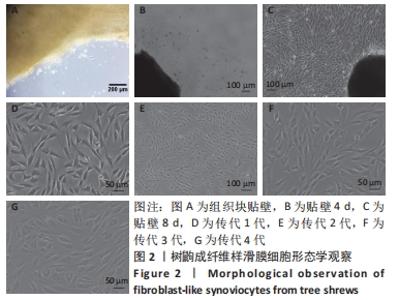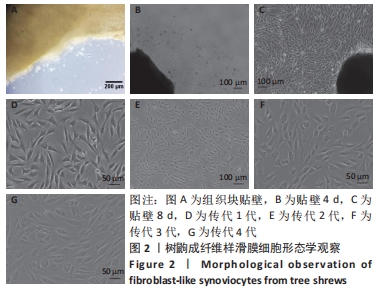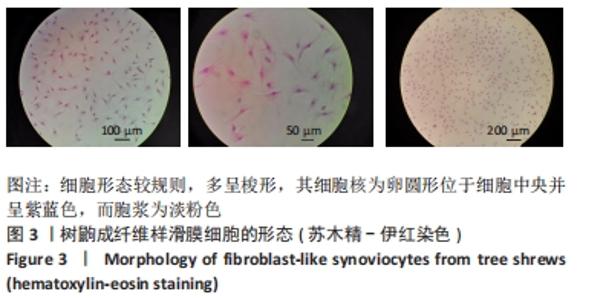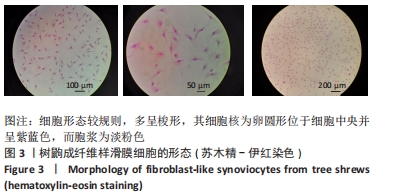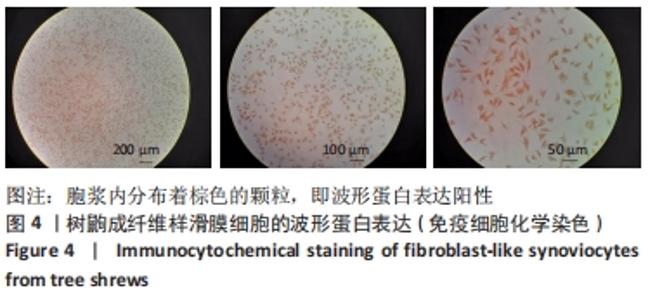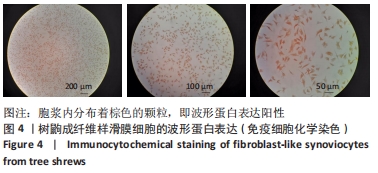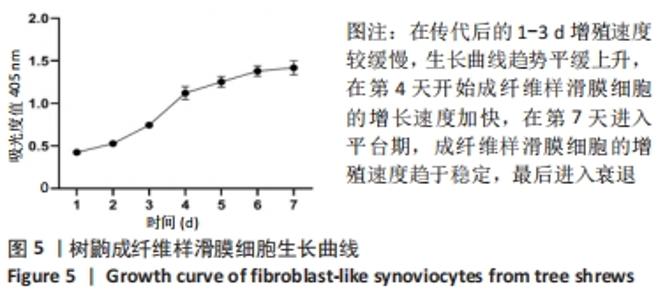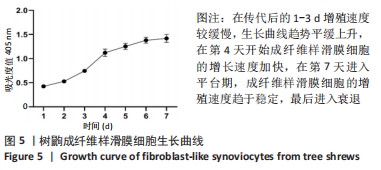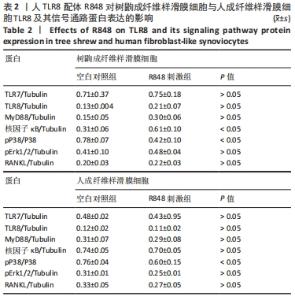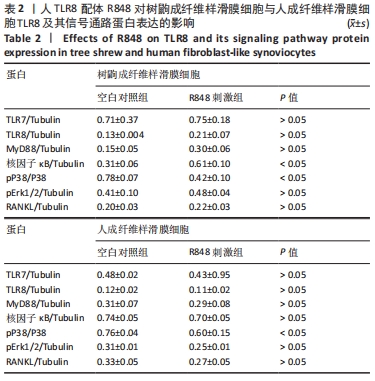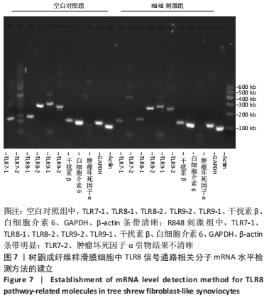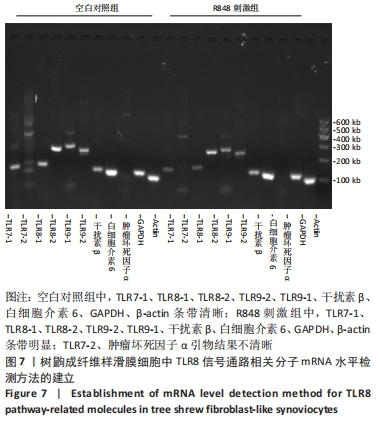Chinese Journal of Tissue Engineering Research ›› 2022, Vol. 26 ›› Issue (23): 3721-3727.doi: 10.12307/2022.673
Previous Articles Next Articles
Isolation and identification of fibroblast-like synoviocytes from tree shrews and establishment of TLR8 pathway related molecular detection methods
Zhou Fanqi1, 2, 3, Li Baoying1, 2, Wang Kaitao1, Tan Quanquan1, Yun Chenxia1, 2, Leng Jing1, 2
- 1School of Basic Medicine, Guangxi University of Chinese Medicine, Nanning 530200, Guangxi Zhuang Autonomous Region, China; 2Guangxi Key Laboratory of Translational Medicine for Treating High-Incidence Infectious Diseases with Integrative Medicine, Nanning 530200, Guangxi Zhuang Autonomous Region, China; 3Laboratory of Liuzhou People’s Hospital, Liuzhou 545000, Guangxi Zhuang Autonomous Region, China
-
Received:2021-07-14Accepted:2021-08-13Online:2022-08-18Published:2022-02-23 -
Contact:Yun Chenxia, Professor, School of Basic Medicine, Guangxi University of Chinese Medicine, Nanning 530200, Guangxi Zhuang Autonomous Region, China; Guangxi Key Laboratory of Translational Medicine for Treating High-Incidence Infectious Diseases with Integrative Medicine, Nanning 530200, Guangxi Zhuang Autonomous Region, China Leng Jing, Professor, School of Basic Medicine, Guangxi University of Chinese Medicine, Nanning 530200, Guangxi Zhuang Autonomous Region, China; Guangxi Key Laboratory of Translational Medicine for Treating High-Incidence Infectious Diseases with Integrative Medicine, Nanning 530200, Guangxi Zhuang Autonomous Region, China -
About author:Zhou Fanqi, Master, School of Basic Medicine, Guangxi University of Chinese Medicine, Nanning 530200, Guangxi Zhuang Autonomous Region, China; Guangxi Key Laboratory of Translational Medicine for Treating High-Incidence Infectious Diseases with Integrative Medicine, Nanning 530200, Guangxi Zhuang Autonomous Region, China; Laboratory of Liuzhou People’s Hospital, Liuzhou 545000, Guangxi Zhuang Autonomous Region, China Li Baoying, Master, School of Basic Medicine, Guangxi University of Chinese Medicine, Nanning 530200, Guangxi Zhuang Autonomous Region, China; Guangxi Key Laboratory of Translational Medicine for Treating High-Incidence Infectious Diseases with Integrative Medicine, Nanning 530200, Guangxi Zhuang Autonomous Region, China Zhou Fanqi and Li Baoying contributed equally to this work. -
Supported by:the National Natural Science Foundation of China (Regional Program), No. 31660632 (to YCX); Guangxi Natural Science Fund Project, No. 2016GXNSFAA380179 (to YCX); Master’s Graduate Student Innovation Project of Guangxi University of Chinese Medicine, No. YCSZ2020018 (to LBY)
CLC Number:
Cite this article
Zhou Fanqi, Li Baoying, Wang Kaitao, Tan Quanquan, Yun Chenxia, Leng Jing. Isolation and identification of fibroblast-like synoviocytes from tree shrews and establishment of TLR8 pathway related molecular detection methods[J]. Chinese Journal of Tissue Engineering Research, 2022, 26(23): 3721-3727.
share this article
Add to citation manager EndNote|Reference Manager|ProCite|BibTeX|RefWorks
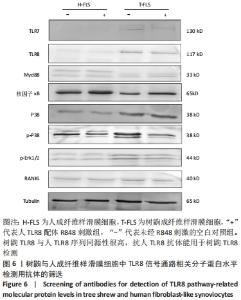
2.5 可与树鼩成纤维样滑膜细胞TLR8蛋白及其信号通路蛋白结合的抗体 通过Western Blot选用Invitrogen和Abcam中可以检测人源蛋白的抗体进行检测,并将提取的树鼩成纤维样滑膜蛋白与人成纤维样滑膜细胞蛋白进行了对照,筛选出了可以结合树鼩TLR7、TLR8、MyD88、核因子kB、P38、p-P38、p-Erk1/2、RANKL以及内参Tubulin的抗体,树鼩与人对应蛋白的检测结果一致,见图6,表明树鼩TLR8与人TLR8序列同源性很高,抗人TLR8 抗体能用于树鼩 TLR8 检测。此次实验也证实了人TLR8配体R848激活上调TLR8蛋白的表达,并且激活相应的信号通路蛋白。"
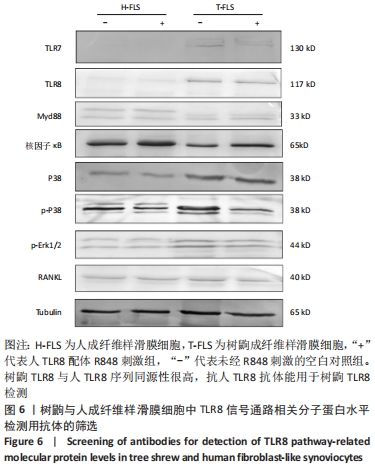
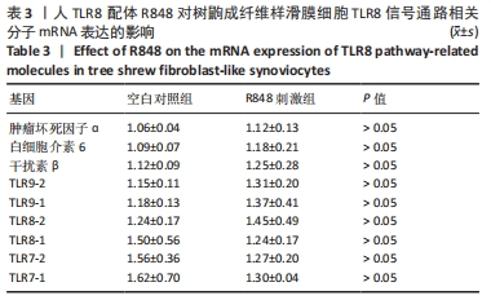
经文献检索以及利用PubMed上发布的树鼩基因序列进行引物设计,通过RT-PCR检测了TLR8相关信号通路蛋白TLR7、TLR8、TLR9,及其信号通路下游炎症因子干扰素β、白细胞介素6、肿瘤坏死因子α以及内参GAPDH、β-actin mRNA的表达,空白对照组中,TLR7-1、TLR8-1,TLR8-2、TLR9-2、TLR9-1、干扰素β、白细胞介素6、GAPDH、β-actin条带清晰;R848刺激组中,TLR7-1、TLR8-1,TLR8-2、TLR9-2、TLR9-1、干扰素β、白细胞介素6、GAPDH、β-actin条带明显;但设计的TLR7-2、肿瘤坏死因子α引物结果不清晰,其他实验结果表明设计的引物合适,可用于后续研究中。与空白对照组比较,R848刺激组树鼩成纤维样滑膜细胞的TLR8通路相关mRNA表达水平无显著变化(P > 0.05),见表3,后续还需继续探讨。"
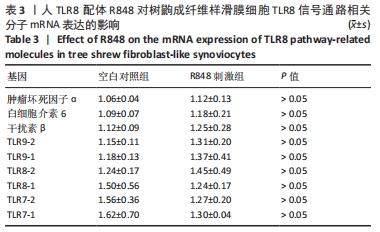
| [1] SMOLEN JS, ALETAHA D, BARTON A, et al. Rheumatoid arthritis. Nat Rev Dis Primers. 2018;4:18001. [2] DEL RMJ, VALIN Á, USATEGUL A, et al. Senescent synovial fibroblasts accumulate prematurely in rheumatoid arthritis tissue s and display an enhanced inflammatory phenotype. Immun Ageing. 2019;16:29. [3] YUE T, FAN X, ZHANG Z, et al. Downregulation of lncRNA ITSN1-2 correlates with decreased disease risk and activity of rheumatoid arthritis (RA), and reduces RA fibroblast-like synoviocytes proliferation and inflammation via inhibiting NOD2/RIP2 signaling pathway. Am J Transl Res. 2019;11(8):4650. [4] 奚正德,张冬青,张雁云,等.小鼠胶原诱导性关节炎的研究进展[J].自然杂志,2003,25(1):36-41. [5] 仇海文,李卉,刘振州,等.Ⅱ型胶原诱导的关节炎大鼠滑膜成纤维细胞的培养、纯化和鉴定[J].南京师大学报(自然科学版),2017, 40(3):128-132. [6] AZUSHIMA K, GURLEY SB, COFFMAN TM. Modelling diabetic nephropathy in mice. Nat Rev Nephrol. 2018;14:48-56. [7] ESTEVES PJ, ABRANTES J, BALDAUF HM, et al. The wide utility of rabbits as models of human diseases. Exp Mol Med. 2018;50:1-10. [8] ZHAO Y , WANG J, KUANG D, et al. Susceptibility of tree shrew to SARS-CoV-2 infection. Sci Rep. 2020;10:16007. [9] 薛丽香,张凤珠,孙瑞娟,等.我国疾病动物模型的研究现状和展望[J].中国科学:生命科学,2014,44(9):851-861. [10] 徐林,张云,梁斌,等.实验动物树鼩和人类疾病的树鼩模型研究概述[J].动物学研究,2013,34(2):59-69. [11] SACRE S, LO A, GREGORY B, et al. Oligodeoxynucleotide inhibition of Toll-like receptors 3, 7, 8, and 9 suppresses cytokine production in a human rheumatoid arthritis model. Eur J Immunol. 2016;46(3):772-781. [12] 司徒镇强,吴军正.细胞培养[M].2版.西安:世界图书出版西安公司,2007:57-63. [13] 王强,韩隆胤,魏赈权,等.断藤益母汤对类风湿关节炎成纤维样滑膜细胞MEKK2及CIA小鼠关节炎的影响[J].中国实验方剂学杂志,2020,26(7):31-41. [14] 邵玉宝,鲍兰馨,汪陶荣,等.丹皮酚通过调节中脑星形细胞神经营养因子的表达及细胞质/核易位抑制类风湿关节炎成纤维滑膜细胞炎症反应[J].中国药理学通报,2021,37(7):958-964. [15] 刘琴,王丽平,陈芳,等.悬浮组织块法分离培养兔成纤维样滑膜细胞[J].中国免疫学杂志,2016,32(7):1009-1012. [16] BRENTANO F, SCHORR O, GAY RE, et al. RNA released from necrotic synovial fluid cells activates rheumatoid arthritis synovial fibroblasts via Toll-like receptor 3. Arthritis Rheum. 2005;52:2656-2665 [17] PICCININI AM, WILLIAMS L, MCCANN FE, et al. Investigating the role of toll-like receptors in Models of Arthritis. Mol Biol (Clifton, NJ). 2016; 1390:351-381. [18] CHOUDHARY N, BHATT LK, PRABHAVALKAR KS. Experimental animal models for rheumatoid arthritis. Immunopharmacol Immunotoxicol. 2018;40(3):193-200. [19] FISCHER BD, ADEYEMO A, O’LEARY ME, et al. Animal models of rheumatoid pain: experimental systems and insights. Arthritis Res Ther. 2017;30;19(1):146. [20] 黄英,陈哲,王玉,等.中药对类风湿关节炎成纤维滑膜细胞的影响[J].中华中医药学刊,2017,35(8):2095-2097. [21] 黄淑敏,钟森杰,廖晓倩,等.基于中西医临床病症特点的类风湿性关节炎动物模型分析[J].中国中药杂志,2021,46(19):5152-5158. [22] LU T, PENG H, ZHONG L, et al. The Tree Shrew as a Model for Cancer Research. Front Oncol. 2021;11:653236. [23] ROMER S, BENDER H, KNABE W, et al. Neural progenitors in the developing neocortex of the northern tree shrew (Tupaia belangeri) show a closer relationship to gyrencephalic primates than to lissencephalic rodents. Front Neuroanat. 2018;12:29. [24] ZHANG J, LUO RC, MAN XY, et al. The anatomy of the skin of the Chinese tree shrew is very similar to that of human skin. Zool Res. 2020;41:208-212. [25] 匡德宣,孙晓梅,代解杰,等.实验树齣主要内分泌器官的组织学观察[J].中国比较医学杂志, 2014,24(6):35-39. [26] 王颖君,陈群,冷静,等.树鼩主要免疫器官组织学研究[J].广西中医药大学学报,2013,16(2):16-18. [27] 周思齐,李皓桓.人成纤维样滑膜细胞原代培养的改良方法[J].广西医学,2019,41(2):212-215. [28] EDWARDS JC. Fibrolast biology.Development and differentiation of synovial fibroblasts in arthritis. Arthritis Res.2000;2(5):344-347. [29] HANS PK, MICHAEL BB. Building the synovium: cadherin-11 mediates fibroblast-like synoviocyte cell-to-cell adhesion. Arthritis Res Ther. 2005;7(2):207-220. [30] 肖楚吟,潘云峰,郭兴华,等.滑膜成纤维细胞的原代培养及生物特性[J].中国医学工程,2010,18(2):1-4. [31] 刘琴,陈芳,朱以良,等.一种新的佐剂性关节炎兔成纤维样滑膜细胞分离培养法[J].第二军医大学学报,2019,40(7):793-797. [32] 陈芳,刘琴,王丽平,等.改良组织块法分离培养兔成纤维样滑膜细胞[J].中国比较医学杂志,2016,26(4):75-78+85. [33] ABDELWAHAB A, PALOSAARI S, ABDELWAHAB SA, et al. Differential synovial tissue expression of TLRs in seropositive and seronegative rheumatoid arthritis: A preliminary report. Autoimmun. 2021;54(1): 23-34. [34] CHEN JQ, SZODORAY P, ZEHER M. Toll-Like Receptor Pathways in Autoimmune Diseases. Clin Rev Allergy Immunol. 2016;50(1):1-17. [35] LEITE PA, BITOUN S, PAOLETTI A, et al. Characterization of Phenotypes and Functional Activities of Leukocytes From Rheumatoid Arthritis Patients by Mass Cytometry. Frontiers in Immunol. 2019;10:2384. [36] TORIGOE, M, SAKATA K, ISHII A, et al. Hydroxychloroquine efficiently suppresses inflammatory responses of human class-switched memory B cells via Toll-like receptor 9 inhibition. Clin Immunol. 2018;195:1-7. [37] NANKE Y, KOBASHIGAWA T, YAGO T, et al. RANK expression and osteoclastogenesis in human monocytes in peripheral blood from rheumatoid arthritis patients. Biomed Res Int. 2016:4874195. [38] Kim KW, Kim BM, Won JY, et al. Toll-like receptor 7 regulates osteoclastogenesis in rheumatoid arthritis. J Biochem. 2019;166(3): 259-270. [39] GUIDUCCI C, GONG M, CEPIKA AM, et al. RNA recognition by human TLR8 can lead to autoimmune inflammation. J Exp Med. 2013;210(13): 2903-2919. [40] UGOLINI M, GERHARD J, BURKERT S, et al. Recognition of microbial viability via TLR8 drives TFH cell differentiation and vaccine responses. Nat Immunol. 2018;19(4):386-396. |
| [1] | Zhang Lichuang, Xu Hao, Ma Yinghui, Xiong Mengting, Han Haihui, Bao Jiamin, Zhai Weitao, Liang Qianqian. Mechanism and prospects of regulating lymphatic reflux function in the treatment of rheumatoid arthritis [J]. Chinese Journal of Tissue Engineering Research, 2022, 26(9): 1459-1466. |
| [2] | Liu Jin, Li Zhen, Hao Huiqin, Wang Ze, Zhao Caihong, Lu Wenjing. Ermiao san aqueous extract regulates proliferation, migration, and inflammatory factor expression of fibroblast-like synovial cells in collagen-induced arthritis rats [J]. Chinese Journal of Tissue Engineering Research, 2022, 26(5): 688-693. |
| [3] | Zhao Yuwei, Gao Yuting, Li Zhen, Hao Huiqin . Mechanism of Ermiao San in the treatment of rheumatoid arthritis [J]. Chinese Journal of Tissue Engineering Research, 2022, 26(5): 742-748. |
| [4] | Li Shidan, Xing Wei, Xie Xiaoyu, Li Youbin, Wang Shaochuan, Fei Jun. A new method for extracting human bone marrow mesenchymal stem cells and the comparison with traditional methods [J]. Chinese Journal of Tissue Engineering Research, 2022, 26(24): 3814-3820. |
| [5] | Zhong Ziling, Qu Shenhong, Han Xing, Wu Di. Isolation, culture and identification of rabbit auricular chondrocytes [J]. Chinese Journal of Tissue Engineering Research, 2022, 26(23): 3633-3637. |
| [6] | Qiao Linghui, Yuan Tao, Han Jie, Wang Guancheng, Gu Yanglin. Screening and biological function analysis of inflammation-related circRNAs in synovial tissue of patients with primary knee osteoarthritis [J]. Chinese Journal of Tissue Engineering Research, 2022, 26(23): 3683-3690. |
| [7] | Yang Chao, Zhong Gejia, Liu Chunfang, Lin Na. Research progress of rheumatoid arthritis animal model with high expression of anti-citrullinated protein antibodies [J]. Chinese Journal of Tissue Engineering Research, 2022, 26(18): 2930-2937. |
| [8] | Wang Xinyuan, Huang Xiabing, Li Juan, Deng Xin. Network pharmacology and molecular docking analysis on Taohong Siwu Decoction for rheumatoid arthritis and osteoarthritis based on the concept of “Treating Different Diseases with the Same Therapeutic Principle” [J]. Chinese Journal of Tissue Engineering Research, 2022, 26(15): 2419-2425. |
| [9] | Liu Qing, Wan Bijiang. Effect of acupotomy therapy on the expression of Bcl-2/Bax in synovial tissue of collagen-induced arthritis rats [J]. Chinese Journal of Tissue Engineering Research, 2021, 25(5): 729-734. |
| [10] | Li Hongzhu, Yuan Si, Zhao Jiaying, Lu Liming, Xu Nenggui. Meta-analysis of acupuncture and moxibustion combined with Duhuo Jisheng Decoction in treating rheumatoid arthritis [J]. Chinese Journal of Tissue Engineering Research, 2021, 25(32): 5232-5239. |
| [11] | Qu Xiangyang, Song Qinyong. Piezo 1 mediates apoptosis of fibroblast-like synovial cells in rheumatoid arthritis via MAPK/ERK5 signaling pathway [J]. Chinese Journal of Tissue Engineering Research, 2021, 25(26): 4156-4161. |
| [12] | Ruan Guangping, Yao Xiang, Liu-Gao Miyang, Cai Xuemin, Li Zian, Pang Rongqing, Wang Jinxiang, Pan Xinghua. Umbilical cord mesenchymal stem cell transplantation for traumatic systemic inflammatory response syndrome in tree shrews [J]. Chinese Journal of Tissue Engineering Research, 2021, 25(25): 3994-4000. |
| [13] | Shen Fu, Kuang Gaoyan, Yang Zhuo, Wen Meng, Zhu Kaimin, Yu Guizhi, Xu Wuji, Deng Bo . Immune infiltration mechanism of differential expression genes in rheumatoid arthritis and potential therapeutic prediction of Chinese herbs [J]. Chinese Journal of Tissue Engineering Research, 2021, 25(14): 2183-2191. |
| [14] | Ruan Guangping, Yao Xiang, Cai Xuemin, Li Zian, Pang Rongqing, Pan Xinghua. Effect of umbilical cord mesenchymal stem cell transplantation for treating systemic lupus erythematosus in a tree shrew model [J]. Chinese Journal of Tissue Engineering Research, 2021, 25(1): 90-95. |
| [15] | Chen Jinsong, Wang Zhonghan, Chang Fei, Liu He. Tissue engineering methods for repair of articular cartilage defect under special conditions [J]. Chinese Journal of Tissue Engineering Research, 2020, 24(8): 1272-1279. |
| Viewed | ||||||
|
Full text |
|
|||||
|
Abstract |
|
|||||
